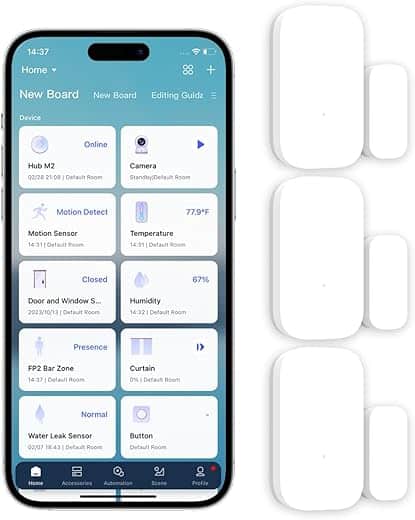Unlocking the Future of Home Automation
Join us as we explore how to enhance our living spaces with motion sensors, optimizing convenience and security in our homes. Together, let’s unlock a smarter way of living, transforming every corner of our house into a responsive, welcoming environment.
What We Need for Our Transformation
Innovative Motion Sensor Automation Ideas for Smart Homes
Choosing the Right Motion Sensors
Confused by Choices? Let’s Simplify It!Identify your needs. Start by considering the purpose of the motion sensors. Do we want to enhance security, automate lights, or save energy? Understanding our primary goal will guide our selection.
Explore the types. Familiarize ourselves with the main types of motion sensors:
Research brands and models. Search for reviews comparing features and reliability. For instance, the Philips Hue Motion Sensor is regarded for its seamless integration with smart lighting.
Budget wisely. Set a price range. We can find effective models that don’t break the bank, ensuring we get the best value for our investment.
By pinpointing our needs and understanding the available options, we’ll be well-equipped to select the perfect motion sensors.
Mapping Out the Best Locations
Where Should We Place These Sensors? The Key to Success!Assess traffic flow. Begin by observing our daily routines. Identify areas where we frequently move, such as hallways, entrances, and staircases. For example, installing a sensor in a hallway can automatically trigger lights when we walk in, making our home more inviting.
Consider lighting conditions. Evaluate natural light levels in each area. We should avoid placing sensors directly in front of windows, as sunlight can cause false triggers. Instead, let’s position them in shaded spots. For instance, a sensor placed in a dimly lit corner will operate more efficiently and enhance our light automation.
Privacy is key. Strategize placements that respect our privacy. Avoid sensor locations that might invade personal spaces, such as bathrooms or bedrooms. Instead, focus on common areas like living rooms or entryways, ensuring both security and comfort.
Test flexibility. Don’t hesitate to experiment! Temporarily place sensors in various spots to gauge their effectiveness before final installation. This way, we can find the perfect balance between responsiveness and our lifestyle needs.
Mapping out our sensor locations carefully ensures they enhance our home experience without interruptions or unintended consequences.
Installation: Getting Our Hands Dirty
Ready, Set, Install! It’s Easier Than You Think!Prepare for installation. Gather all necessary tools and materials, including a drill, screwdriver, and mounting brackets. Check the motion sensor packaging for any additional components we might need for setup.
Mount the sensors. Start by choosing our pre-approved locations. Use a stud finder to locate the best spots on the walls, ensuring secure attachment. If we’re mounting a wall sensor, typically around 5 to 7 feet high is ideal to detect movement effectively. Follow the manufacturer’s instructions to secure the sensor in place.
Connect to a hub or smart system. If we have a smart home hub, connect our motion sensor according to the specific guidelines. This generally involves downloading the app, creating an account, and following the prompts to add the device. For example, connecting a Ring Motion Sensor to the Ring app is simple and guided step-by-step.
Test functionality. After installation, manually walk through the detection zone to ensure the sensor triggers as expected. Adjust the angle slightly if necessary to improve performance. For instance, if we notice a delayed response, we might need to tilt the sensor downwards for better detection.
With everything installed and tested, our motion sensors are now ready to enhance our home automation setup!
Integrating with Smart Home Systems
Let’s Make Our Devices Talk to Each Other!Choose a compatible smart home ecosystem. Start by ensuring our motion sensors work seamlessly with our existing system, whether it’s Google Home, Apple HomeKit, or Amazon Alexa. Check product descriptions and user reviews for compatibility before purchasing.
Download the necessary apps. Once we’ve confirmed compatibility, download and install the relevant apps for both the motion sensors and our smart home system. For instance, if we choose a Philips Hue Motion Sensor, we’ll need the Philips Hue app alongside our smart home app.
Link devices. Open the smart home app and follow the prompts to integrate the motion sensors. This usually involves scanning a QR code or entering a setup code found on the sensor. For example, with Alexa, we might say, “Alexa, discover devices,” and watch as our motion sensor joins the network.
Create automation routines. After linking, let’s set up automated actions. We can program our motion sensors to turn on lights when movement is detected or send us notifications when someone enters specific areas. For instance, a sensor at our front door could alert us with a push notification when visitors arrive.
Test and adjust. Finally, walk through the detection zones to ensure the automation works as planned. If we notice delays or missed triggers, refine the settings in the app. Frequent adjustments help optimize performance for our unique lifestyle.
Integrating our motion sensors with smart home systems enhances convenience and security, creating a synchronized living environment.
Fine-Tuning Settings for Maximum Efficiency
Unlocking Hidden Features: Are We Using Our Sensors Right?Adjust sensitivity levels. Start by accessing the settings in the motion sensor’s app. High sensitivity can cause unnecessary alerts from pets or moving objects. For example, if we have a cat that roams freely, lowering the sensitivity can prevent false alarms, ensuring alerts only trigger from human movement.
Set schedules. Take advantage of programmable schedules. By defining when we want the motion sensors active—like during evenings when we are home—we can prevent unnecessary notifications during the day. Let’s plan a routine where lights automatically turn on at sunset and off at sunrise, tailoring the system to our bedtime habits.
Utilize zones. If our motion sensor allows it, utilize zone settings to define specific areas for detection. For instance, we can set a sensor in a high-traffic hallway to alert us when someone passes through while ignoring an adjacent quiet room. This makes our alerts more relevant and reduces clutter.
Test functionality periodically. Regularly walk through the areas to ensure everything works as intended. If we notice issues, such as a light not turning on when it should, we can revisit the app settings to tweak them further.
Fine-tuning these settings ensures our motion sensors work harmoniously within our daily lives, enhancing convenience and minimizing disruptions.
Embracing the Smart Home Revolution
By harnessing the power of motion sensors, we’re not just upgrading our home; we’re stepping into the future of living. Let’s give this technology a try and share our experiences—together, we can redefine our comfort!



Leave a Reply